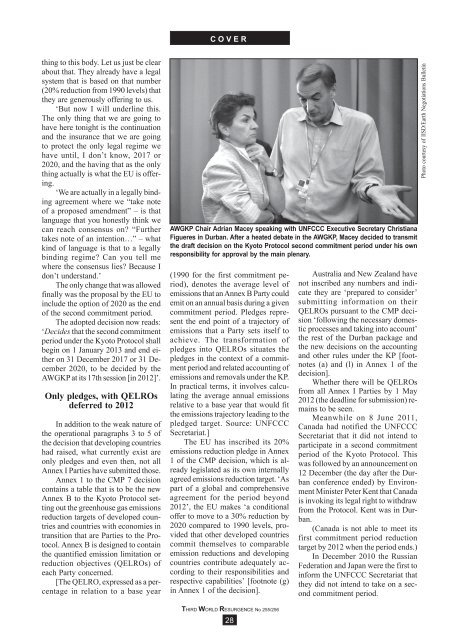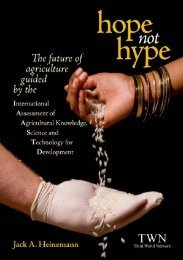Download - Third World Network
Download - Third World Network
Download - Third World Network
Create successful ePaper yourself
Turn your PDF publications into a flip-book with our unique Google optimized e-Paper software.
C O V E R<br />
thing to this body. Let us just be clear<br />
about that. They already have a legal<br />
system that is based on that number<br />
(20% reduction from 1990 levels) that<br />
they are generously offering to us.<br />
‘But now I will underline this.<br />
The only thing that we are going to<br />
have here tonight is the continuation<br />
and the insurance that we are going<br />
to protect the only legal regime we<br />
have until, I don’t know, 2017 or<br />
2020, and the having that as the only<br />
thing actually is what the EU is offering.<br />
‘We are actually in a legally binding<br />
agreement where we “take note<br />
of a proposed amendment” – is that<br />
language that you honestly think we<br />
can reach consensus on? “Further<br />
takes note of an intention…” – what<br />
kind of language is that to a legally<br />
binding regime? Can you tell me<br />
where the consensus lies? Because I<br />
don’t understand.’<br />
The only change that was allowed<br />
finally was the proposal by the EU to<br />
include the option of 2020 as the end<br />
of the second commitment period.<br />
The adopted decision now reads:<br />
‘Decides that the second commitment<br />
period under the Kyoto Protocol shall<br />
begin on 1 January 2013 and end either<br />
on 31 December 2017 or 31 December<br />
2020, to be decided by the<br />
AWGKP at its 17th session [in 2012]’.<br />
Only pledges, with QELROs<br />
deferred to 2012<br />
In addition to the weak nature of<br />
the operational paragraphs 3 to 5 of<br />
the decision that developing countries<br />
had raised, what currently exist are<br />
only pledges and even then, not all<br />
Annex I Parties have submitted those.<br />
Annex 1 to the CMP 7 decision<br />
contains a table that is to be the new<br />
Annex B to the Kyoto Protocol setting<br />
out the greenhouse gas emissions<br />
reduction targets of developed countries<br />
and countries with economies in<br />
transition that are Parties to the Protocol.<br />
Annex B is designed to contain<br />
the quantified emission limitation or<br />
reduction objectives (QELROs) of<br />
each Party concerned.<br />
[The QELRO, expressed as a percentage<br />
in relation to a base year<br />
AWGKP Chair Adrian Macey speaking with UNFCCC Executive Secretary Christiana<br />
Figueres in Durban. After a heated debate in the AWGKP, Macey decided to transmit<br />
the draft decision on the Kyoto Protocol second commitment period under his own<br />
responsibility for approval by the main plenary.<br />
(1990 for the first commitment period),<br />
denotes the average level of<br />
emissions that an Annex B Party could<br />
emit on an annual basis during a given<br />
commitment period. Pledges represent<br />
the end point of a trajectory of<br />
emissions that a Party sets itself to<br />
achieve. The transformation of<br />
pledges into QELROs situates the<br />
pledges in the context of a commitment<br />
period and related accounting of<br />
emissions and removals under the KP.<br />
In practical terms, it involves calculating<br />
the average annual emissions<br />
relative to a base year that would fit<br />
the emissions trajectory leading to the<br />
pledged target. Source: UNFCCC<br />
Secretariat.]<br />
The EU has inscribed its 20%<br />
emissions reduction pledge in Annex<br />
1 of the CMP decision, which is already<br />
legislated as its own internally<br />
agreed emissions reduction target. ‘As<br />
part of a global and comprehensive<br />
agreement for the period beyond<br />
2012’, the EU makes ‘a conditional<br />
offer to move to a 30% reduction by<br />
2020 compared to 1990 levels, provided<br />
that other developed countries<br />
commit themselves to comparable<br />
emission reductions and developing<br />
countries contribute adequately according<br />
to their responsibilities and<br />
respective capabilities’ [footnote (g)<br />
in Annex 1 of the decision].<br />
Australia and New Zealand have<br />
not inscribed any numbers and indicate<br />
they are ‘prepared to consider’<br />
submitting information on their<br />
QELROs pursuant to the CMP decision<br />
‘following the necessary domestic<br />
processes and taking into account’<br />
the rest of the Durban package and<br />
the new decisions on the accounting<br />
and other rules under the KP [footnotes<br />
(a) and (l) in Annex 1 of the<br />
decision].<br />
Whether there will be QELROs<br />
from all Annex I Parties by 1 May<br />
2012 (the deadline for submission) remains<br />
to be seen.<br />
Meanwhile on 8 June 2011,<br />
Canada had notified the UNFCCC<br />
Secretariat that it did not intend to<br />
participate in a second commitment<br />
period of the Kyoto Protocol. This<br />
was followed by an announcement on<br />
12 December (the day after the Durban<br />
conference ended) by Environment<br />
Minister Peter Kent that Canada<br />
is invoking its legal right to withdraw<br />
from the Protocol. Kent was in Durban.<br />
(Canada is not able to meet its<br />
first commitment period reduction<br />
target by 2012 when the period ends.)<br />
In December 2010 the Russian<br />
Federation and Japan were the first to<br />
inform the UNFCCC Secretariat that<br />
they did not intend to take on a second<br />
commitment period.<br />
Photo courtesy of IISD/Earth Negotiations Bulletin<br />
THIRD WORLD RESURGENCE No 255/256<br />
28
















